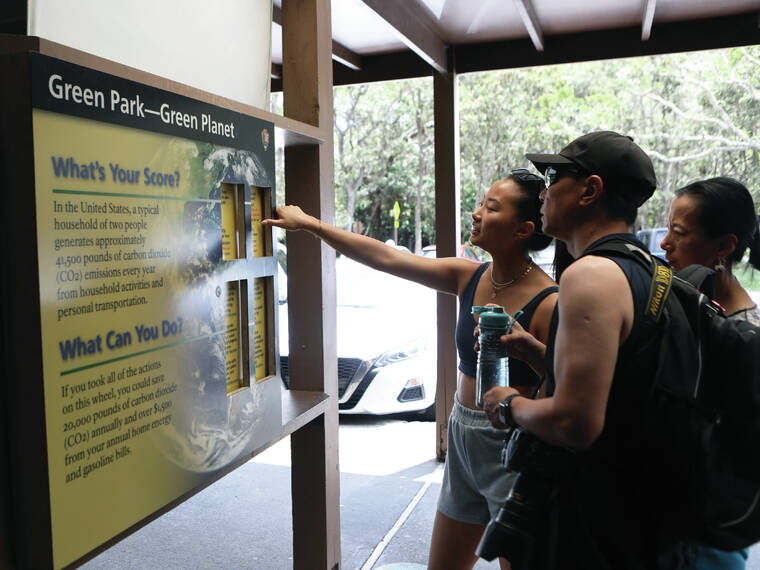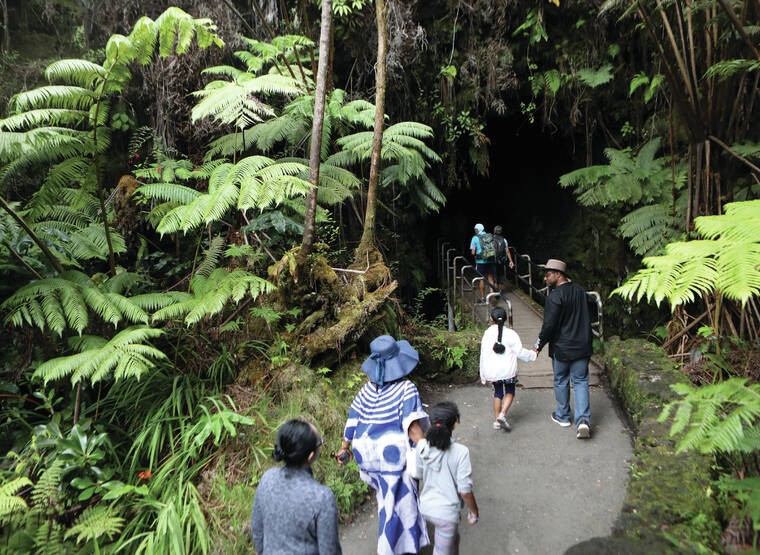Hawaii economic report ‘pessimistic’; recession expected in 2023

A family uses an interactive sign at the Hawaii Volcanoes National Park visitors center on Aug. 29. (Kelsey Walling/Hawaii Tribune-Herald)

Families take turns walking into Nahuku, or the Thurston Lava Tube, last month in Hawaii Volcanoes National Park. Robust spending by North American visitors has partly offset the near-absence of traditionally high-spending Japanese visitors, according to a University of Hawaii report about the state’s economy. (Kelsey Walling/Hawaii Tribune-Herald)
Both the U.S. and Hawaii are headed toward a mild recession, according to a new report released today by the Economic Research Organization at the University of Hawaii.
Both the U.S. and Hawaii are headed toward a mild recession, according to a new report released today by the Economic Research Organization at the University of Hawaii.
“If we were cautious at the time of our last forecast, we are pessimistic now,” the report said. “We are forecasting a U.S. recession for the first half of 2023.”
The impact on Hawaii is expected to be less severe than that on the mainland, but high inflation, higher travel costs and the Federal Reserve’s interest rate hikes will still adversely impact Hawaii households and businesses.
The report was compiled prior to the Fed’s decision on Wednesday to raise benchmark interest rates by another three-quarters of a percentage point, with the intention of continually hiking rates until the funds level hits a “terminal rate,” or end point, of 4.6% in 2023.
Hawaii’s saving grace might be the return of tourists from Japan, which is expected to alleviate net job losses and cushion economic impacts, according to the report.
“The timing of Hawaii’s international tourism recovery will provide needed lift as growth in other sectors slows in 2023,” the report said. “Japanese visitors are finally returning to the islands, even as a weak yen and high costs weigh on their vacation spending.”
Thrice-weekly nonstop flights from Japan Airlines between Tokyo and Kailua-Kona returned this summer, although none are scheduled for October.
The return of Japanese tourists is partially due to the country raising its daily cap on visitors from 20,000 to 50,000 this month, as well as allowing travelers who received at least one booster shot to skip the preentry COVID-19 testing requirement.
The report forecasts that for 2022, Hawaii will see a 2,000% increase of Japanese visitors from the year before, with Hawaii County anticipating roughly 29,300 tourists from Japan.
Japan traditionally led the tourism market in daily expenditures, spending nearly four times as much on shopping alone. But the value of the yen depreciating by 25% could result in less overall spending.
The daily average for room rates in July was listed at $384 for the state, or 45% above what it was during the same month in 2019.
The absence of Japanese tourists has been offset by an increase in Canadian visitors.
“Canadian arrivals have continued to post solid gains, and they are running at more than three-quarters of their prepandemic level,” the report said.
Domestic travelers also have increased their spending.
“Robust spending by North American visitors has partly offset the near-absence of traditionally high-spending Japanese visitors,” the report said. “Real per-person daily spending in July was 5% above the 2019 levels and more than 9% above the summer of last year, primarily because real daily spending by U.S. visitors has surged 10% over the past 12 months.”
Hawaii’s labor force also has started to stabilize following the pandemic, according to the report.
After 170,000 workers became unemployed or left the labor force at the peak of the pandemic, numbers have returned to within 3% of pre-COVID levels despite the net decline in the state’s population.
Minimum wage hikes throughout the state also are expected to offset recession impacts. Next month, the hourly minimum wage will increase from $10.10 to $12, increasing again every two years until it reaches $18 by 2028, although the report cautions that “nominal wage gains are not keeping up with rising prices.”
Rising prices are expected to result in a drop of residents’ total income from all sources by more than 5% this year, the report said.
Housing has been impacted, as well, with Hawaii County reporting the highest single-family home inventory throughout the state in July.
“Rising mortgage interest rates and high home prices have dampened the demand for home buying,” the report said. “As a result, prices have flattened over the past quarter.”
The high cost of materials and labor also factor into the outlook for new construction. While the cost of lumber had declined 10% from its high in March, it is still 40% above 2019 levels.
A shortage of construction labor also has impacted the industry, along with difficulty obtaining permits.
“On both the Big Island and Oahu, builders have reported that these delays have in some cases led to lost work and even layoffs,” the report said, adding Hawaii continues to benefit from large federal infrastructure contracts which are expected to increase construction jobs in 2023.
Another $600 million allocated to the Department of Hawaiian Home Lands will assist with new housing construction in the future.
“While Hawaii will likely escape an outright contraction in economic activity, it will still be adversely affected by softer global conditions, further interest rate hikes, and temporarily high inflation,” the report said. “Significant downside risks exist, given the perilous path facing the U.S. and global economies.”
Email Grant Phillips at gphillips@hawaiitribune-herald.com.


